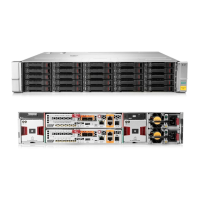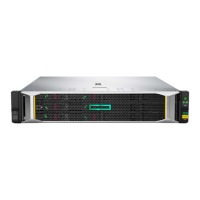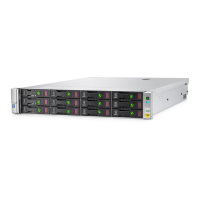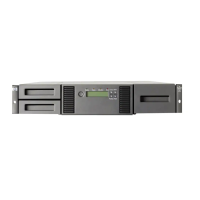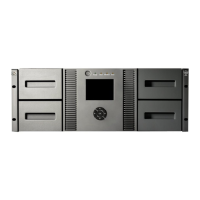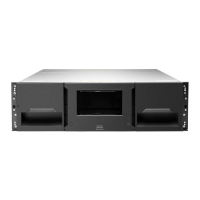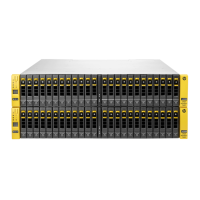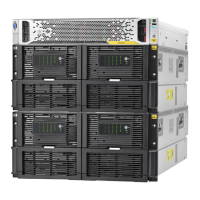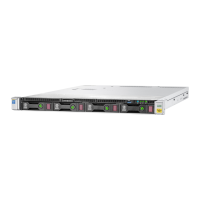






Do you have a question about the HP Storevirtual 4000 and is the answer not in the manual?
Learn how to create HP LeftHand Storage using iSCSI and Fibre Channel networks, including management groups and volumes.
Configure RAID and network settings on individual storage systems before adding them to a management group or cluster.
Connect application servers to storage volumes by creating server or server clusters for iSCSI or Fibre Channel access.
Learn how to resolve issues like storage systems not being found and configure remote support for HP LeftHand Storage.
Identify HP platforms used for LeftHand models and find links to platform-specific documentation for hardware details.
Perform essential tasks on storage systems, including logging in/out, changing hostnames, and locating systems in a rack.
Learn procedures for powering off or rebooting storage systems, including those with modular components, safely.
View the status of dedicated boot devices like compact flash cards or hard drives in the storage system.
Learn to manage RAID settings, choose configurations, set rebuild rates, and monitor RAID status for storage systems.
Understand descriptions of available RAID levels (RAID 1, RAID 5, RAID 6, RAID 10) and their requirements.
Plan RAID configurations for storage systems based on data availability, I/O performance, and usable capacity.
Ensure data safety and availability by using disk RAID and Network RAID for redundancy and high availability.
Implement network best practices for SAN isolation, IP addressing, flow control, and split network configurations.
Understand how changing network configuration affects connectivity and follow HP recommendations for updates.
Configure or change network interface settings like speed, duplex, and frame size before creating NIC bonds.
Learn to change speed and duplex settings for storage systems and network switches to ensure compatibility.
Set the time zone and date/time for the management group, ensuring all storage systems inherit the same settings.
Configure storage systems to use Network Time Protocol (NTP) servers for time management instead of local system time.
Manually edit the date, time, and time zone for management groups if an NTP service is not used.
Add, edit, and remove administrative users, manage their permissions, and change passwords.
Create and manage administrative groups, defining permission levels and assigning users to groups.
Simplify user authentication by integrating with Active Directory for centralized user management.
Monitor overall SAN health and status using the SAN Status Page, including best practices and component status.
Customize the layout and content of the SAN Status Page to highlight the most important information.
Understand alarms and events, their severity, and how to configure event notification via email or SNMP.
Understand the roles of management groups in providing administrative domain, organizing storage, and ensuring security.
Plan for each component before creating a management group, including storage systems, users, and date/time settings.
Step-by-step guide to creating a management group, naming it, adding storage systems, and configuring initial settings.
Understand the role of managers in governing storage system activity, controlling data replication, and managing communication.
Learn about the voting algorithm for coordinating storage systems and the importance of quorum for SAN/iQ function.
Understand Failover Managers as specialized managers for automated failover and quorum tie-breaking in clusters.
Consider storage system capacity and system count when creating clusters and adding systems for optimal performance.
Follow steps to create additional clusters in existing management groups, including assigning VIPs.
Perform cluster maintenance tasks like adding, swapping, reordering, or removing storage systems.
Analyze factors affecting SAN capacity: RAID level, data protection, and snapshot configuration.
Configure volume size, data protection levels, and provisioning methods like full or thin provisioning.
Configure data protection levels (Network RAID) for volumes based on redundancy needs and available storage systems.
Assign volumes to servers for access by application servers, covering iSCSI and Fibre Channel connectivity.
Plan volume creation considering factors like number, size, data protection, snapshots, and growth strategy.
Understand the different types of volumes: primary, remote, and SmartClone, and their specific uses.
Differentiate between regular and application-managed snapshots, and understand their consistency and requirements.
Learn how to use snapshots for backups, data preservation, and protection against data deletion.
Consider snapshot purpose, size, and schedules, including data change rates and cluster capacity.
Understand SmartClone volumes as space-efficient copies of volumes or snapshots, dependent on a clone point.
Explore typical use cases for SmartClone volumes, such as deploying virtual machines and data mining.
Install the HP LeftHand CLI for automation and scripting, and access the CLI User Guide and sample scripts.
Add server connections to management groups and assign volumes or snapshots, covering iSCSI and Fibre Channel.
Grant iSCSI server connections access to volumes or snapshots, setting permissions and enabling load balancing.
Ensure clusters, volumes, and servers are connected via iSCSI and have compatible SAN/iQ software versions.
Use the Performance Monitor to understand SAN load, capacity, impact of backups, and identify performance issues.
Analyze disk activity characteristics like access type, size, pattern, and queue depth to understand workloads.
List of advanced features like Multi-Node Virtualization, Managed Snapshots, and Remote Copy that require licensing.
Understand the evaluation period, its limitations, and consequences of not obtaining a license key.
Learn how to start the evaluation period for advanced features by configuring them in the CMC.
Use iSCSI protocol for server access to volumes, leveraging VIPs and load balancing for performance and fault tolerance.
Understand Virtual IP addresses for highly available cluster access, VIP load balancing, and requirements for usage.
Simplify iSCSI target discovery on networks with multiple clusters by configuring an iSNS server.
Access the Configuration Interface via terminal emulation on Windows or Linux/UNIX systems.
Connect using a null modem cable and terminal emulation program with specific settings for Windows systems.
Learn procedures for replacing disks, rebuilding RAID, and identifying bad disks before replacement.
Gather necessary items and information, including system location, disk position, and replacement disk readiness.
Detailed steps for identifying component failure and replacing the RAID controller, including handling ESD precautions.
Information on contacting HP support, including required details and support website.
Guidelines for ensuring rack stability to protect personnel and equipment, including safety warnings.
Learn how to create HP LeftHand Storage using iSCSI and Fibre Channel networks, including management groups and volumes.
Configure RAID and network settings on individual storage systems before adding them to a management group or cluster.
Connect application servers to storage volumes by creating server or server clusters for iSCSI or Fibre Channel access.
Learn how to resolve issues like storage systems not being found and configure remote support for HP LeftHand Storage.
Identify HP platforms used for LeftHand models and find links to platform-specific documentation for hardware details.
Perform essential tasks on storage systems, including logging in/out, changing hostnames, and locating systems in a rack.
Learn procedures for powering off or rebooting storage systems, including those with modular components, safely.
View the status of dedicated boot devices like compact flash cards or hard drives in the storage system.
Learn to manage RAID settings, choose configurations, set rebuild rates, and monitor RAID status for storage systems.
Understand descriptions of available RAID levels (RAID 1, RAID 5, RAID 6, RAID 10) and their requirements.
Plan RAID configurations for storage systems based on data availability, I/O performance, and usable capacity.
Ensure data safety and availability by using disk RAID and Network RAID for redundancy and high availability.
Implement network best practices for SAN isolation, IP addressing, flow control, and split network configurations.
Understand how changing network configuration affects connectivity and follow HP recommendations for updates.
Configure or change network interface settings like speed, duplex, and frame size before creating NIC bonds.
Learn to change speed and duplex settings for storage systems and network switches to ensure compatibility.
Set the time zone and date/time for the management group, ensuring all storage systems inherit the same settings.
Configure storage systems to use Network Time Protocol (NTP) servers for time management instead of local system time.
Manually edit the date, time, and time zone for management groups if an NTP service is not used.
Add, edit, and remove administrative users, manage their permissions, and change passwords.
Create and manage administrative groups, defining permission levels and assigning users to groups.
Simplify user authentication by integrating with Active Directory for centralized user management.
Monitor overall SAN health and status using the SAN Status Page, including best practices and component status.
Customize the layout and content of the SAN Status Page to highlight the most important information.
Understand alarms and events, their severity, and how to configure event notification via email or SNMP.
Understand the roles of management groups in providing administrative domain, organizing storage, and ensuring security.
Plan for each component before creating a management group, including storage systems, users, and date/time settings.
Step-by-step guide to creating a management group, naming it, adding storage systems, and configuring initial settings.
Understand the role of managers in governing storage system activity, controlling data replication, and managing communication.
Learn about the voting algorithm for coordinating storage systems and the importance of quorum for SAN/iQ function.
Understand Failover Managers as specialized managers for automated failover and quorum tie-breaking in clusters.
Consider storage system capacity and system count when creating clusters and adding systems for optimal performance.
Follow steps to create additional clusters in existing management groups, including assigning VIPs.
Perform cluster maintenance tasks like adding, swapping, reordering, or removing storage systems.
Analyze factors affecting SAN capacity: RAID level, data protection, and snapshot configuration.
Configure volume size, data protection levels, and provisioning methods like full or thin provisioning.
Configure data protection levels (Network RAID) for volumes based on redundancy needs and available storage systems.
Assign volumes to servers for access by application servers, covering iSCSI and Fibre Channel connectivity.
Plan volume creation considering factors like number, size, data protection, snapshots, and growth strategy.
Understand the different types of volumes: primary, remote, and SmartClone, and their specific uses.
Differentiate between regular and application-managed snapshots, and understand their consistency and requirements.
Learn how to use snapshots for backups, data preservation, and protection against data deletion.
Consider snapshot purpose, size, and schedules, including data change rates and cluster capacity.
Understand SmartClone volumes as space-efficient copies of volumes or snapshots, dependent on a clone point.
Explore typical use cases for SmartClone volumes, such as deploying virtual machines and data mining.
Install the HP LeftHand CLI for automation and scripting, and access the CLI User Guide and sample scripts.
Add server connections to management groups and assign volumes or snapshots, covering iSCSI and Fibre Channel.
Grant iSCSI server connections access to volumes or snapshots, setting permissions and enabling load balancing.
Ensure clusters, volumes, and servers are connected via iSCSI and have compatible SAN/iQ software versions.
Use the Performance Monitor to understand SAN load, capacity, impact of backups, and identify performance issues.
Analyze disk activity characteristics like access type, size, pattern, and queue depth to understand workloads.
List of advanced features like Multi-Node Virtualization, Managed Snapshots, and Remote Copy that require licensing.
Understand the evaluation period, its limitations, and consequences of not obtaining a license key.
Learn how to start the evaluation period for advanced features by configuring them in the CMC.
Use iSCSI protocol for server access to volumes, leveraging VIPs and load balancing for performance and fault tolerance.
Understand Virtual IP addresses for highly available cluster access, VIP load balancing, and requirements for usage.
Simplify iSCSI target discovery on networks with multiple clusters by configuring an iSNS server.
Access the Configuration Interface via terminal emulation on Windows or Linux/UNIX systems.
Connect using a null modem cable and terminal emulation program with specific settings for Windows systems.
Learn procedures for replacing disks, rebuilding RAID, and identifying bad disks before replacement.
Gather necessary items and information, including system location, disk position, and replacement disk readiness.
Detailed steps for identifying component failure and replacing the RAID controller, including handling ESD precautions.
Information on contacting HP support, including required details and support website.
Guidelines for ensuring rack stability to protect personnel and equipment, including safety warnings.
| Model | HP StoreVirtual 4000 |
|---|---|
| Category | Storage |
| Form Factor | 2U |
| Controller | Dual controllers |
| Hard Drives Supported | SAS, SATA |
| Number of Hard Drives Supported | Up to 24 |
| Drive Bays | 24 |
| Processor | Intel Xeon |
| Power Supply | Redundant Power Supplies |
| Warranty | 3 years |
| RAID Levels | 0, 1, 5, 6, 10 |
| Connectivity | iSCSI |
| Supported Protocols | iSCSI, NFS, CIFS |
| Drive Types Supported | SAS, SATA, SSD |
| Network Interfaces | 4 x 1GbE |
| Management Software | HP StoreVirtual Central Management Console |
| Operating System | LeftHand OS |
